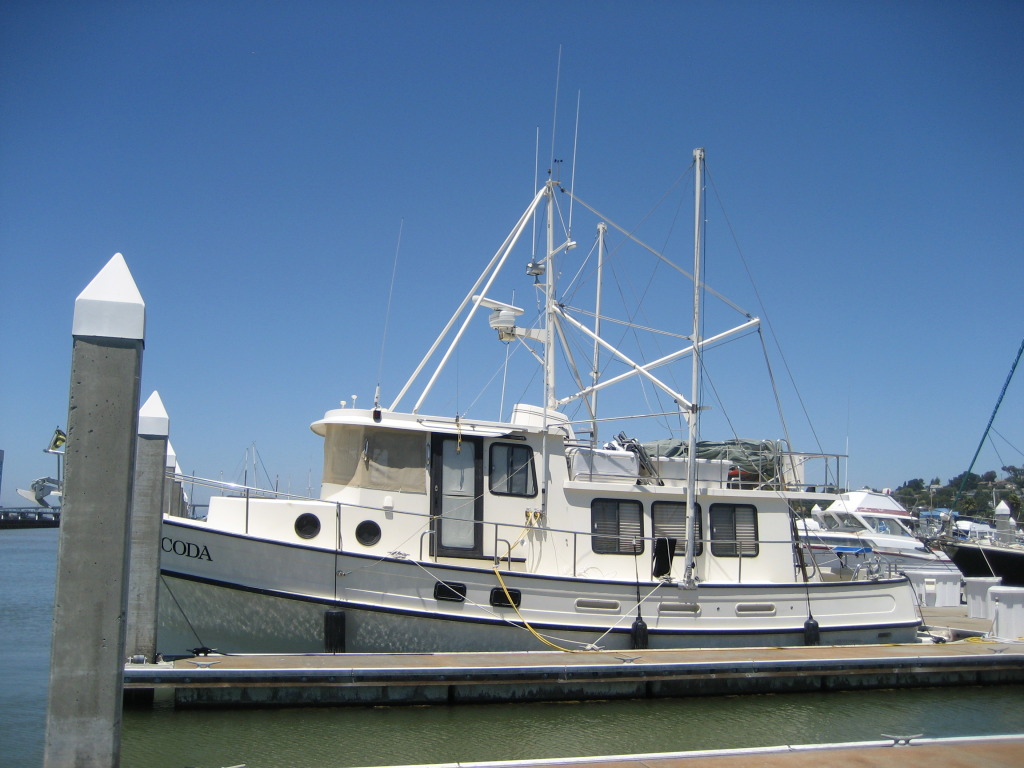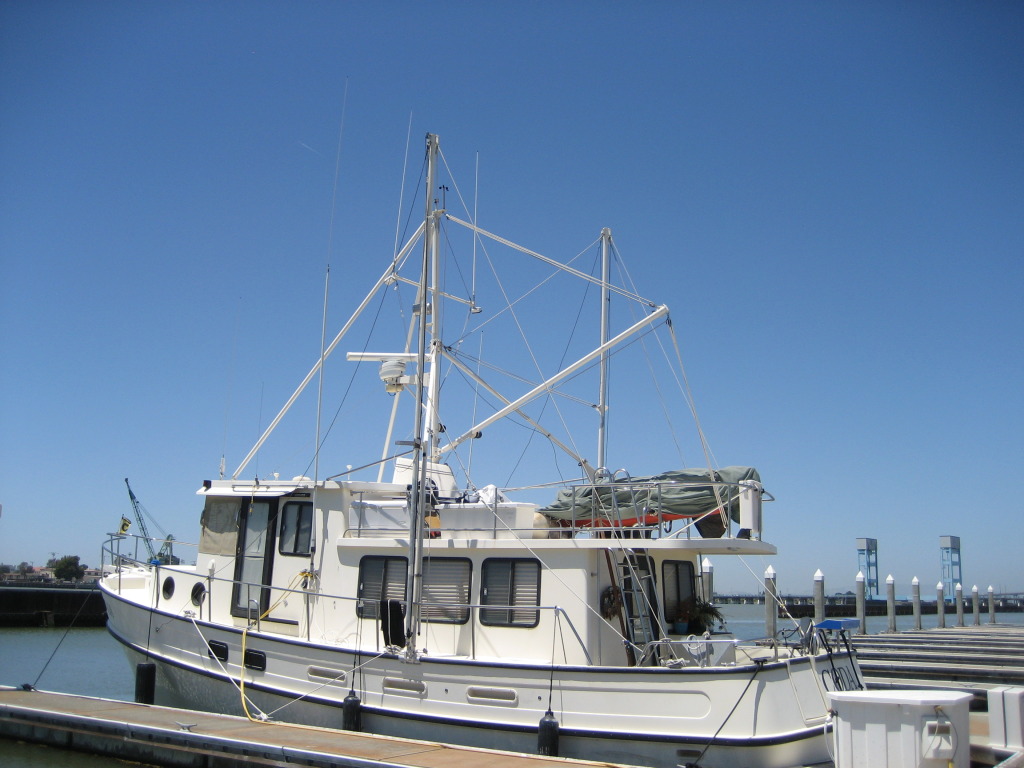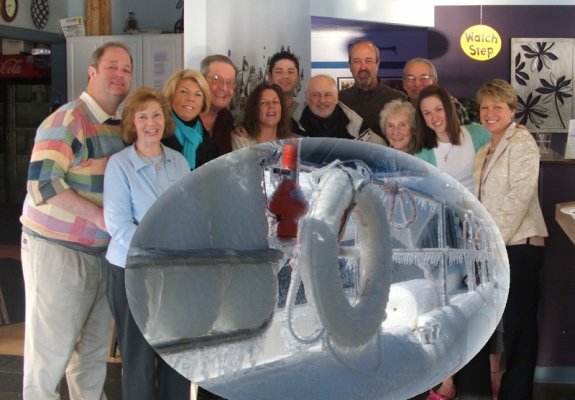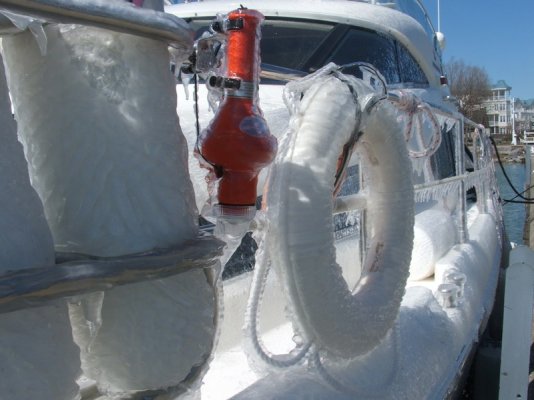So I have been reading and researching trawlers with the intent of basing in the S.E., do the loop, Bahamas, etc... In researching boats, I was wondering about this forum's opinion on what size is practical for single-handed boating. Although my standard complement is two (my wife and I), this means we need to plan on managing with one at times. We are both experienced on sail boats up to about 36 feet. Since we will be living aboard, we've been considering sizes from the mid 30s into the 50's. I'd like to go as large as reasonably possible while still meeting our budget, practical for the ICW/loop and manageable for one. Thoughts? Practical experience? Thank you.
You are using an out of date browser. It may not display this or other websites correctly.
You should upgrade or use an alternative browser.
You should upgrade or use an alternative browser.
Single-Hand Cruising
- Thread starter rlbride
- Start date
The friendliest place on the web for anyone who enjoys boating.
If you have answers, please help by responding to the unanswered posts.
If you have answers, please help by responding to the unanswered posts.
Daddyo
Guru
I've run our 48' from Marathon to Maine solo. It really depends on the boat and the operator not the length. Anchoring out takes less crew than docking, etc. Your personal comfort level is critical as well.
markpierce
Master and Commander
- Joined
- Sep 25, 2010
- Messages
- 12,557
- Location
- USA
- Vessel Name
- Carquinez Coot
- Vessel Make
- penultimate Seahorse Marine Coot hull #6
Something like this would be more than sufficient. One would do alright with a bit shorter.


My Coot would do alright, although you probably should avoid the optional auxiliary sails if you're keen on the loop.


My Coot would do alright, although you probably should avoid the optional auxiliary sails if you're keen on the loop.
Last edited:
Bay Pelican
Moderator Emeritus
Opinions will vary. In considering the question of what is an appropriate boat to do the loop single-handed I have focused on access to the dock from the steering station. This favors the pilothouse type trawler with full walk around decks. Getting down from a flying bridge is more difficult than walking out a port or starboard door. Some pilothouse trawlers do not have 360 degree visibility from the pilothouse. I would avoid these. The American and Nordic Tugs do.
Best arrangement I have seen for single-handling was a Nordic Tug (?) perhaps a 39 or 42 with both bow and stern thrusters.
Marty
Best arrangement I have seen for single-handling was a Nordic Tug (?) perhaps a 39 or 42 with both bow and stern thrusters.
Marty
FF
Guru
- Joined
- Oct 12, 2007
- Messages
- 22,552
Boat size doesnt matter much , the layout is more important.
IF you can toss a midship line to a dock hand easily , thats about all you need .
Many boats will need an extra midship cleat installed , to be safer .
IF you can toss a midship line to a dock hand easily , thats about all you need .
Many boats will need an extra midship cleat installed , to be safer .
.................... IF you can toss a midship line to a dock hand easily , thats about all you need .
There may be times when no dock hand is available. You'll have to be able to step onto the dock (with lines in your hands) or reach a piling or cleat from the boat. The tool mentioned in this thread:http://www.trawlerforum.com/forums/s3/new-boat-toy-12481.html might help.
Last edited:
ranger58sb
Guru
So I have been reading and researching trawlers with the intent of basing in the S.E., do the loop, Bahamas, etc... In researching boats, I was wondering about this forum's opinion on what size is practical for single-handed boating. Although my standard complement is two (my wife and I), this means we need to plan on managing with one at times. We are both experienced on sail boats up to about 36 feet. Since we will be living aboard, we've been considering sizes from the mid 30s into the 50's. I'd like to go as large as reasonably possible while still meeting our budget, practical for the ICW/loop and manageable for one. Thoughts? Practical experience? Thank you.
Within reason, size is less important than layout. Quick access from helm to mid-ship's cleats for spring lines is one of the first things I'd check. I think there's at least one thread on the topic around here some place, and a search would likely find it...
For the Loop, you'll want to examine fixed air draft; I think max is something like 19'1" or thereabouts.
-Chris
jwnall
Moderator Emeritus
In researching boats, I was wondering about this forum's opinion on what size is practical for single-handed boating. Since we will be living aboard, we've been considering sizes from the mid 30s into the 50's. I'd like to go as large as reasonably possible while still meeting our budget, practical for the ICW/loop and manageable for one. Thoughts? Practical experience? Thank you.
You will most likely get a lot of opinions on this one, and probably some very good advice. I have been singlehanding for about 6 years now. First with a 39' sailboat, and now with a 36' trawler. With a good autopilot, the only real problems have been in docking with windy conditions or a strong current, or both. With a dockhand available, not usually a problem. But by yourself, if the boat is too large to easily pull up to the dock and hold with one hand while securing to the cleat with the other hand, then it can be a problem. For that reason, and only that reason, I think that 36' is about my limit for singlehanding. Just my opinion, and worth every cent of what it costs.
Daddyo
Guru
You will most likely get a lot of opinions on this one, and probably some very good advice. I have been singlehanding for about 6 years now. First with a 39' sailboat, and now with a 36' trawler. With a good autopilot, the only real problems have been in docking with windy conditions or a strong current, or both. With a dockhand available, not usually a problem. But by yourself, if the boat is too large to easily pull up to the dock and hold with one hand while securing to the cleat with the other hand, then it can be a problem. For that reason, and only that reason, I think that 36' is about my limit for singlehanding. Just my opinion, and worth every cent of what it costs.
The irony is I really think the larger boats to a degree are much easier around docks. I have owned 17,27,36,48 footers and the weight and predictability of the larger boat make her much easier in docking situations. She is less effected by wind, waves, motion etc then the smaller boats. Everything near docks happens at a slower more predictable pace.
jwnall
Moderator Emeritus
The irony is I really think the larger boats to a degree are much easier around docks. I have owned 17,27,36,48 footers and the weight and predictability of the larger boat make her much easier in docking situations. She is less effected by wind, waves, motion etc then the smaller boats. Everything near docks happens at a slower more predictable pace.
Interesting, as I would not have thought that, but certainly do take your word for it.
The irony is I really think the larger boats to a degree are much easier around docks. I have owned 17,27,36,48 footers and the weight and predictability of the larger boat make her much easier in docking situations. She is less effected by wind, waves, motion etc then the smaller boats. Everything near docks happens at a slower more predictable pace.
I agree, the mass of larger boats compared to smaller ones does put most docking items into seemingly "slow-motion"... however, tidal currents move big or little boats pretty much the same. Difference is small boats may be able to be temporally held against the current with arm power while looping lines to cleats, whereas larger boats may require more power than just arms... especially during single hand docking operations!
And, twin screw makes most docking considerably easy to accomplish! With twins as well as front and back thrusters then docking could nearly be done with a remote while you sat at the club house imbibing!

River Cruiser
Guru
- Joined
- Jan 25, 2013
- Messages
- 1,357
- Location
- US
- Vessel Name
- Northern Lights II
- Vessel Make
- Bayliner 3870
I singlehand 60 to 70% of the time. On anchoring in current I don't leave the helm as I have a windlass switch at the upper helm, because of where I anchor & how the current can move the boat I wouldn't try it even with a windlass if I had to leave the helm. I agree a 360 view from the lower helm is a must for maneuvering near docks & other boats, especially if wind & current are a concern, I don't have thrusters & that I'am sure colors my opinion. Mine is 38' with twin diesel power & I don't think I would want anything bigger. Good luck
FF
Guru
- Joined
- Oct 12, 2007
- Messages
- 22,552
>if the boat is too large to easily pull up to the dock and hold with one hand while securing to the cleat with the other hand, then it can be a problem.<
A problem that can easily be solved with mere currency.
Lots of cruising folks will chose a vertical capstan at the bow , and stick on a used sail geared winch at the stern to male line handling a non issue.
A powered self tailing winch near the midship cleat might just do the job.
A problem that can easily be solved with mere currency.
Lots of cruising folks will chose a vertical capstan at the bow , and stick on a used sail geared winch at the stern to male line handling a non issue.
A powered self tailing winch near the midship cleat might just do the job.
If you're seriously considering doing the "loop", you should join this group:
America's Great Loop Cruisers' Association
They can tell you a lot about what will work best on this cruise.
Several people have done the loop and written about it. A search on amazon.com will turn up a few books that can be pretty interesting.
America's Great Loop Cruisers' Association
They can tell you a lot about what will work best on this cruise.
Several people have done the loop and written about it. A search on amazon.com will turn up a few books that can be pretty interesting.
SCOTTEDAVIS
Guru
I was of the understanding that they really want you to have two on board when you lock, is this not the case?
Is locking single hand a problem? Any suggestions to make it easier?
Is locking single hand a problem? Any suggestions to make it easier?
jwnall
Moderator Emeritus
I was of the understanding that they really want you to have two on board when you lock, is this not the case?
Is locking single hand a problem? Any suggestions to make it easier?
It is certainly easier with two, but I've done a bunch of them singlehanding and never had a mishap. Just used a couple of snatch blocks so that I could stand in one place and control both forward and aft lines.
Moonstruck
Guru
- Joined
- Nov 27, 2008
- Messages
- 8,276
- Location
- USA
- Vessel Name
- Moonstruck
- Vessel Make
- Sabre 42 Hardtop Express
I was of the understanding that they really want you to have two on board when you lock, is this not the case?
Is locking single hand a problem? Any suggestions to make it easier?
Not a real problem. It should be a breeze with your boat. Having access to the midship cleat, you can get control of the situation very easily. Also if no floating bollards (they will be there on most of the big lifts), you can ask the lockmaster for a slow ride. Most will accomodate.
David Carter just did a passel of locks solo last year. His thread gives a good account of what you would be faced with. Maybe David will pick up on this.
River Cruiser
Guru
- Joined
- Jan 25, 2013
- Messages
- 1,357
- Location
- US
- Vessel Name
- Northern Lights II
- Vessel Make
- Bayliner 3870
The locks around my area #21 thru #25 have allowed me to float thru when singlehanding. On the 508 mile trip down last year we went thru 20 locks & we floated over half of them, this is on the upper Mississippi River.I was of the understanding that they really want you to have two on board when you lock, is this not the case? Is locking single hand a problem? Any suggestions to make it easier?
SCOTTEDAVIS
Guru
Great information, thanks guys. 
I like the snatch block idea, can see that working very smooth.

I like the snatch block idea, can see that working very smooth.
psneeld
Guru
Great Bridge/Dismal Locks in Va just want you to hand a line that they loop around a bollard/cleat and you take back and tend up or down. They don't seem to care what you do as long as you look like you will stay relatively put.
Better a good single hander than many that pass through those locks.
Better a good single hander than many that pass through those locks.
jwnall
Moderator Emeritus
Better a good single hander than many that pass through those locks.
That is so true. I've had many an amused moment (both singlehanding and with my wife on the aft end) watching a newbie barking out orders to his wife (I presume -- don't think a mistress would put up with it) and just completely screwing things up. How can you screw up getting through a lock, now, come on! But, as they say in my part of the country, some people can screw up a one car funeral.
psneeld
Guru
True...read the Panama Canal regs and you'll give up that dream if you are faint hearted.Not all locks are equal ... upbound (pleasurecraft) in the St.Lawrence Seaway and Welland canal locks, a crew of three is mandatory. Downbound a crew of two is mandatory.
micksbuddy
Veteran Member
I've single handed my Mainship 34(single engine) around the Great Loop, including all the locks, and up and down the east coast a few times. Even though I run the boat from the flybridge, I can get from the helm to the midship cleat in about 4 seconds, which suffices in all but the most adverse wind/current situations. The less mobile you are physically, you'll need better access to the side decks if single handing, imo.
My boat is fairly light and is blown around by the wind pretty easily. And while I haven't got experience piloting bigger, heavier boats, I agree that they would probably be easier to dock, being less susceptible to being blown away from the dock before you can get a line on.
My boat is fairly light and is blown around by the wind pretty easily. And while I haven't got experience piloting bigger, heavier boats, I agree that they would probably be easier to dock, being less susceptible to being blown away from the dock before you can get a line on.
I routinely run 55 -60' boats around the Great Lakes on short deliveries single handed. The only time I have needed assistance docking was bringing a 55 Fairline from Toronto into Oswego at Easter. There was so much ice on the boat I could not get the lines off the rails. There used to be a restaurant in Oswego called "Patz on the River" which was closed on easter.
Fortunately for me the owners were having a family Easter dinner in the restaurant that day. They saw me trying to break the lines off the rails and hang on to the boat at the same time. They not only rushed out to help but they took me in to join the family for one of the best meals I've ever had...... won't be doing anymore deliveries that early in the year anymore..... thats me in the middle.
Fortunately for me the owners were having a family Easter dinner in the restaurant that day. They saw me trying to break the lines off the rails and hang on to the boat at the same time. They not only rushed out to help but they took me in to join the family for one of the best meals I've ever had...... won't be doing anymore deliveries that early in the year anymore..... thats me in the middle.
Attachments
Ron T
Senior Member
- Joined
- Oct 13, 2007
- Messages
- 328
- Location
- USA
- Vessel Name
- Grand Yankee
- Vessel Make
- 1981 49' Grand Banks Classic
Alone
I have run Miami to Long I. Sound and back with both my Cherubini 50' Trawler and G.B49' with out any Oh My Gods. Just think ahead and go slow around docks. Ask for help from Marina you are using on your trip. Never be afraid to ask for help. Have fun.
I have run Miami to Long I. Sound and back with both my Cherubini 50' Trawler and G.B49' with out any Oh My Gods. Just think ahead and go slow around docks. Ask for help from Marina you are using on your trip. Never be afraid to ask for help. Have fun.
There will be times when no help is available. You may arrive after hours or be staying at a dock or park where no help is available. You should have a "plan B" even if it's anchoring and waiting for better conditions............. Ask for help from Marina you are using on your trip. Never be afraid to ask for help..........
Will
Veteran Member
- Joined
- Nov 7, 2013
- Messages
- 75
- Vessel Name
- M.V. LOTTIE
- Vessel Make
- Lien Hwa/Pilothouse LRC
So far I have had success while solo on my 50 footer.
Yes a plan b is always necessary!
Yes a plan b is always necessary!
SaltyDog
Senior Member
- Joined
- Nov 11, 2007
- Messages
- 251
I use a long midship spring line to dock single handed. Eye pre hooked to the cleat, then toss the split coiled line over a cleat or upright part of the dock. Feed the bitter end through the hawser while there is still plenty of slack and under the free horn of the hawser/cleat. Plenty of control taking up the slack. Never needed to pay out more line once the slack was taken up, but that might be the hardest part. A line the length of the boat works for me.
FF
Guru
- Joined
- Oct 12, 2007
- Messages
- 22,552
. A line the length of the boat works for me.
Should a Bo Bo happen a line that will not reach the prop if overboard might be wise.
Should a Bo Bo happen a line that will not reach the prop if overboard might be wise.



